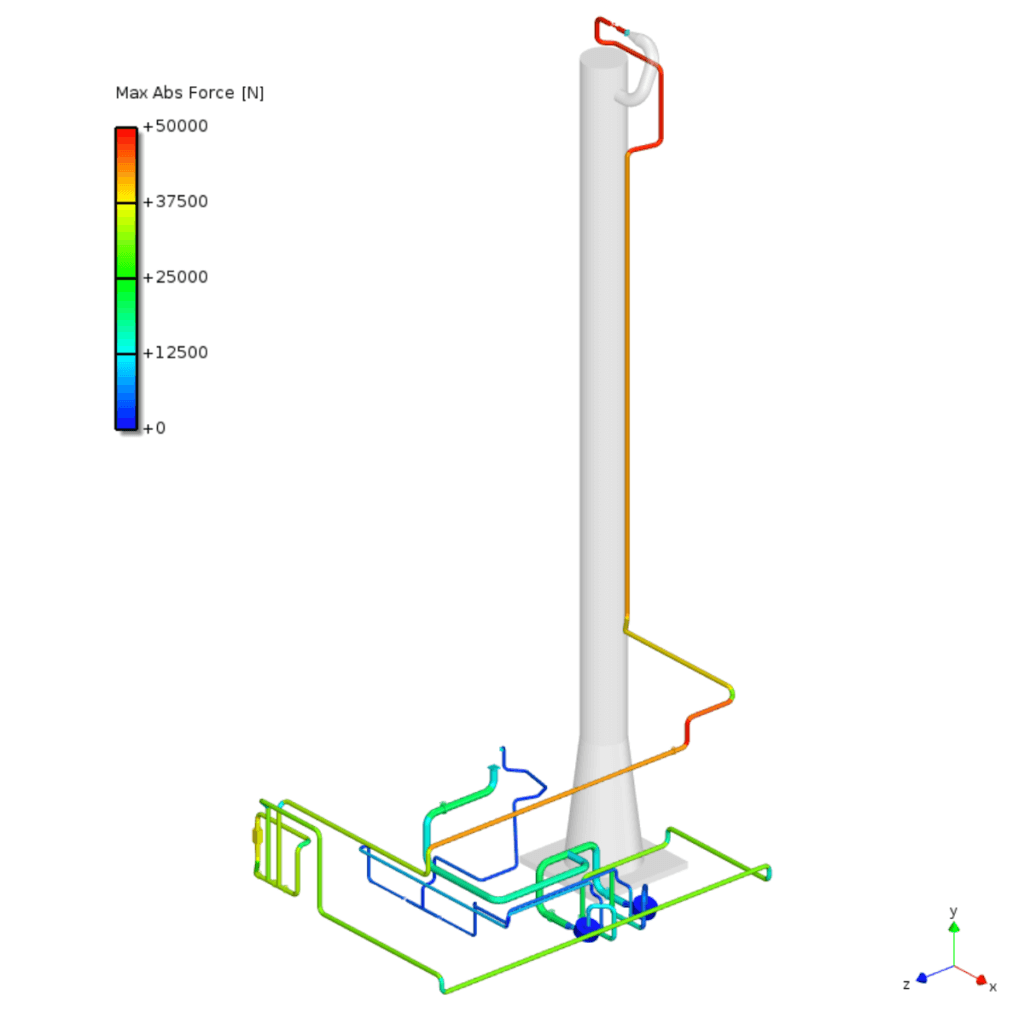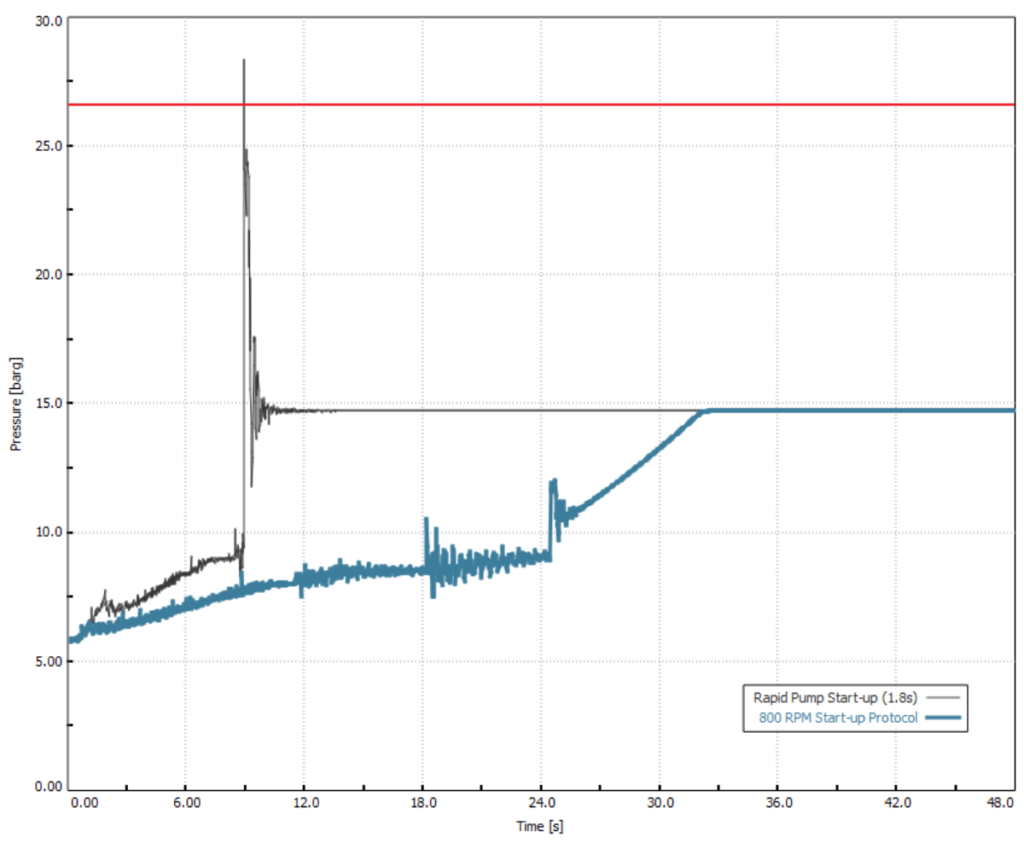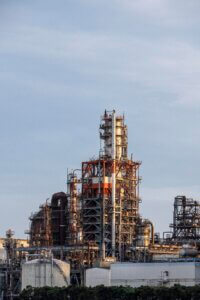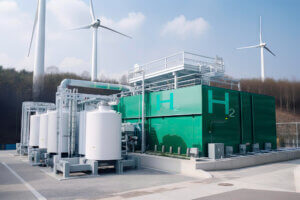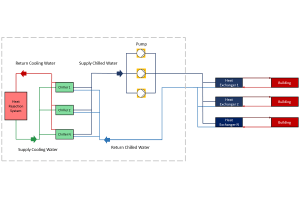Pressure surges ocurr in piping systems whenever there are sudden changes in flow resistance from steady operation. Surges can cause significant damage, also at locations far removed from where they are initiated. For large or complex piping systems, this can make their impact challenging to predict without specialist analysis.
Dynaflow Research Group uses its in-house transient hydraulic simulation software, BOSfluids, to assess piping systems for possible surge issues, by subjecting them to critical scenarios based on the process conditions. This allows us to assess risks, and develop tailored mitigation strategies that enable our clients to limit the impact of pressure surges.
Introduction
This case study is focused on a surge analysis performed for a process line between two distillation columns at BASF Antwerp. BASF is a large-scale producer of chemicals, materials, and surface coatings, operating worldwide. The Antwerp site is one of its largest chemical production centers, spanning more than 50 process installations over 6 km2 of terrain.
DRG has been a recurring collaborator with BASF for over 20 years, providing complex engineering analyses such as surge, stress, and FEA calculations for a wide range of projects.
The process line considered here is in continuous operation. It was deemed that rapid valve operation or unplanned pump rundown could give rise to the occurrence of pressure surges in this line. The client wanted to assess the risk that these surges could pose to system safety and reliability. Also, there was specific interest in having start-up protocols that would minimize process downtime without exceeding allowable pressures and forces on supports.
Background
The surge analysis started with constructing a hydraulic model of the piping system, based on input provided by the client. This model is a one-to-one reflection of the actual piping geometry and contains the fluid properties, operating conditions, and pump and valve characteristics. The model was verified to be representative of the BASF process line by comparing steady-state simulation results to client process conditions (flows and pressures).
Rapid valve operation, unplanned pump rundown, and subsequent start-up were considered critical scenarios. These transient events initiate pressure waves (surges) propagating through the system at high velocity. This causes pressures throughout the process line to temporarily rise or fall, which is accompanied by local force imbalances. Both pressures and forces can exceed the allowable values for which system components are designed if the magnitude of the surge is large. More information on the causes and effects of pressure surges can be found in our recent blog post.
A complicating factor in the present case is that the operating conditions of the line are near the vapor pressure of the process liquid. This is not of influence in the steady state, but a temporary loss of pressure due to a transient event may cause the system to operate below the vapor pressure, and lead to flashing. The process liquid will then start to transition to vapor, in a process similar to boiling. Upon rapid recovery of the pressure, vapor bubbles throughout the line collapse back to the liquid phase, causing shaking effects and high instantaneous loads, similar to cavitation. These effects are complex and hard to capture with hydraulic models alone. But the emergence of vapor in the simulations indicates that extra care should be taken in returning to operating conditions.
To assess the implications of flashing in detail, DRG has a broad range of tools available for more advanced computations. If a detailed analysis is outside the scope of the project, clients can rely on our experience and engineering judgment.
Analysis And Mitigation
In considering the effects of the critical scenarios, the client required loads on supports to remain below 5 kN to avoid damage to the system. The occasional allowable pressure of the piping was calculated as 26.6 barg. For all valve operation and pump rundown scenarios, pressure and force levels remained below these allowables. DRG provided critical valve opening/closure times for which the maximum levels would be just met, to give the client an idea of their safety margin under current valve operating conditions.
In the rapid pump start-up scenarios, however, the allowables were exceeded. Unbalanced forces could reach up to 63 kN in the riser towards the second column (see image below). DRG therefore continued to develop mitigated start-up protocols, to ensure safe operation in case of a system restart. Two tailored strategies were proposed to limit the impact of pressure surges due to pump start-up. It was made sure that both strategies were easy to implement and did not interfere with the client’s operational methods.
As a second strategy, the pump could be started at a low speed initially (800 rpm). This provides just enough pressure head to fill the process line up to its highest point, without outflow to the second column. Under these conditions, the line is filled in 20 seconds. From that moment, the pump is gradually ramped up to its operational speed of 1488 rpm.
Both scenarios require around 35 seconds to get back to full operation. They can be initiated immediately after a rundown of the duty pump, without compromising system safety. In comparison, the minimum start-up time of the pumps was estimated from its power and its impeller inertia as 1.8 seconds. The below graph illustrates the payoff for taking more time to return to operating conditions, as excess peak pressures are avoided. Also, recall that to mitigate excess loads related to quick evaporation or flashing of the process liquid, rapid pressure recovery should be avoided. The start-up protocols developed by DRG do just that.
Graph 1: Process line pressure during system restart
Conclusion
The assessment of the process line at BASF Antwerp highlighted several vulnerabilities to pressure surges, that pose the risk of significant damage if not properly mitigated. Notably, the locations of high surge impact proved to be far removed from where pressure surges are likely to be initiated. Combining hydraulic analysis with engineering judgment, Dynaflow Research Group provided two mitigation strategies for the critical scenario of a system restart after an unplanned pump rundown. Implementation of either of these strategies avoids excess loads on the system and reduces the impact of flashing.
The team at BASF Antwerp responded positively to the conclusions and recommendations made. DRG’s technical report was thorough and illustrated a clear expertise in the analysis and mitigation of pressure surges, stated the project manager at BASF. The proposed mitigation strategies were evaluated by the in-house engineering team at BASF Antwerp, and the pump restart protocol has since been adjusted.


